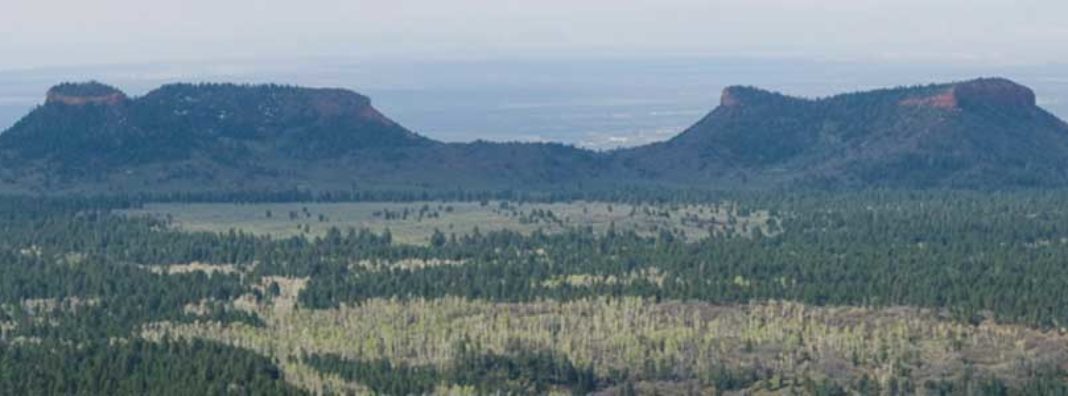
Photo: Francisco Kjolseth/The Salt Lake Tribune via AP
For generations, Bruce Adams and his family have lived off the land by grazing cattle in southeastern Utah. When President Obama designated 1.35 million acres as Bears Ears National Monument in 2016, Adams and other locals worried the change would limit their ability to graze and hunt like they had in the past. The following year, after a review of recently designated monuments, President Trump reduced the size of Bears Ears to just over 200,000 acres. Adams, who serves on the three-person San Juan County commission, praised the president’s decision, noting in one interview for the BBC that only 8 percent of San Juan County is made up of private lands, “So in order for us to survive as citizens here we have to have access and use of the public property.”
Trump’s monument reduction also angered many who felt Bears Ears deserved federal protection and resulted in lawsuits led by environmental groups and tribes asserting the president does not have the authority to reduce the monument. Honor Keeler, a Native American activist and assistant director of the nonprofit Utah Diné Bikéyah, described President Trump’s reduction of Bears Ears as “tearing down a church or temple” and “hand(ing) back in piecemeal the bricks and sacred items that have been destroyed.”
At the heart of the controversy over Bears Ears is the Antiquities Act of 1906, which gives presidents broad discretion to designate and alter national monuments without requiring direct oversight from Congress or input from local stakeholders. The act was intended to allow presidents to quickly preserve areas of historic or scientific interest at risk of being damaged or destroyed. In its current form, the Antiquities Act allows for rapid and abrupt changes in public land management from one administration to the next, leaving local people in the dark.
Monument designations and modifications can mean big changes in how local people can use an area for things like recreation, grazing, and mineral development. For Native American tribes, these designations and modifications can also disrupt or hinder their ability to use the land for sacred rituals and traditional practices. By creating controversy rather than cooperation, this uncertainty undermines the goal of conserving and protecting some of America’s most iconic and beautiful landscapes. In new research published by the Center for Growth and Opportunity, I outline three ways to enact more effective checks and balances that would help us achieve more cooperative management of public lands.
First, policymakers could increase congressional oversight of national monument designations. The Antiquities Act directs the president to designate the “smallest area compatible with the proper care and management of the objects to be protected,” but does not provide guidance on what those terms mean. As a result, nearly two dozen monuments have been designated that encompass more than a million acres. Requiring congressional review of national monument designations over a certain size could act as an effective check on presidential discretion. One way to do this would be to subject monument designations to the Congressional Review Act, which allows Congress to review and overturn rules it finds are unwarranted.
Second, Congress could require consultation with relevant stakeholders before a monument is designated. This would ensure that those who are affected most can voice their concerns and provide input about how an area should be managed. Local residents, business owners, and even state leaders are not always given that chance. For example, President Clinton’s 1996 designation of 1.7 million acres in southern Utah as Grand Staircase-Escalante National Monument took local leaders, including Utah’s then-Gov. Mike Leavitt, by surprise.
More recently, decisions about Bears Ears National Monument sparked questions about whether local stakeholders were properly consulted, both in the monument’s designation and later reduction. Getting local input before a monument is designated would help reduce controversy in favor of cooperation.
Finally, policymakers could require congressional approval for a president to reduce the size of existing national monuments or to rescind them altogether. Future presidents would then need to get input from Congress before making changes like Trump’s recent monument modifications. Allowing the president to undo a monument designation made by his predecessor creates uncertainty about how an area will be managed. Preventing the president from undoing previous decisions with the stroke of a pen would provide more certainty for those who are impacted most.
In its current form, the Antiquities Act gives the president broad decision-making power, creating uncertainty and conflict over how public lands will be managed. If clear checks and balances on presidential authority are put into place, uncertainty and controversy could be reduced in favor of more cooperative management. These changes would allow voices from both sides of the aisle to provide input on how our public lands should be managed for future generations to enjoy.


 Deseret News
Deseret News